Animal Tissue, Skeletal System | Science & Technology for UPSC CSE PDF Download
Animal Tissue
The animal tissues are of 4 types:
Epithelial, Muscular, Connective and Nervous.
Four Type of tissue
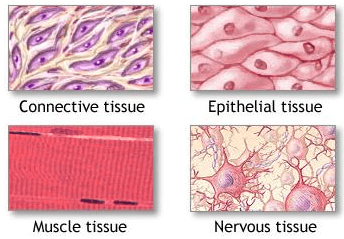
Epithelial Tissue
These are the simplest of all animal tissues that form lining of various internal organs and also cover the surface of the body, one side of the cells is in contact with the basement membrane while the other surface is in contact with the atmosphere either directly (as in skin) or indirectly (as in lungs and alimentary canal). There is no blood or lymph supply to the epithelial tissues, however, nerve supply is present.
Functions of Epithelial Tissues
- Protection. It protects and covers the internal organs that lie beneath from bacteria, viruses, injury, chemicals etc. In the skin the outermost keratinised layer of cells (dead cells) are in contact with the atmosphere that protect the underlying soft tissues.
- Secretion. The glandular epithelial cells (goblet cells) secrete various substances like enzymes, hormones, mucous etc. That is necessary for the normal metabolic activities of the organism.
- Absorption. The intestinal epithelial cells with their microvilli (to increase the surface area) help in the absorption of digested food materials. It is done by columnar cells.
- Sensory. The epithelial cells that are supplied with nerve endings as in the retina of eye, olfactory epithelium etc. help to receive various stimuli from the atmosphere and convey them to the brain.
- Conduction. The ciliated cells found in many of the ducts (trachea etc.) in the body help in transporting materials from one part of the body to another.
- Exceretion. In the region of kidney tubules and sweat glands, the epithelial cells produce substances that are not needed by the body and so are removed out of the body.
Connective Tissues
A connective tissue serves to bind the other tissues and organs and also support the body. In its matrix are present different types of fibres and cells. It originates from loose mesodermal cells (mesenchyme cells) with fine protoplasmic projections. A connective tissue performs the following functions in our body:
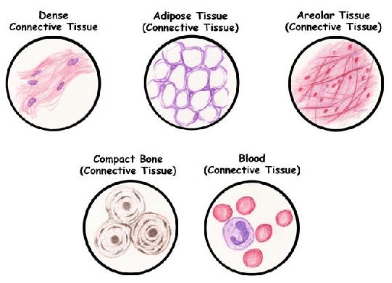
- It binds and connects other tissues of the body. Tendons help to bind muscle to bone, while ligaments join bone to bone.
- It protects the body from foreign substances— plasma cells synthesize antibodies that kill the invading antigens, macrophages ingests bacteria, cell debris etc.
- It provides support, like bone and cartilage, to the body.
- It helps to repair the wear and tear of the body.
- It provides shape to the body.
- It helps to store the reserve food material in the form of fat.
- Myeloid tissue (bone marrow) manufactures blood cells; and lymphoid tissue forms the lymphocytes.
Muscular Tissues
The cells of a muscular tissue contract in response to a given stimulus and then relax back to their original form and shape. This property of the muscular tissue is known as contractibility. These cells do not expand. The muscular tissue brings about movement and locomotion of various organs and parts of the body. The muscle cells are called as fibers as they are thin and elongated. In our body, there are mainly three types of muscular tissues: voluntary, involuntary and cardiac.
In higher animals, the cells which make up the nervous tissue are highly specialised for receiving and conducting the messages or informations from one part of the body to another. Any change in the atmosphere or inside the body acts as a stimulus. For a given stimulus, these cells can be excited and this excitement is passed along the nerve fibers to the specific organs. Therefore, excitability and conductivity are the two fundamental properties of nervous tissue.Nervous Tissue
Skeletal System
 Fig. Human skeleton systemThe rigid frame of the animal is called skeleton. Two types of skeletons are:
Fig. Human skeleton systemThe rigid frame of the animal is called skeleton. Two types of skeletons are:
Exoskeleton and Endoskeleton.
Exoskeleton forms the outer covering of the skin and other soft parts like hairs, nails, scales, feathers etc.
Endoskeleton forms the inner framework of the body and consists of bones and cartilages. In some lower vertebrates like sharks and rays (fishes), the entire endoskeleton is of cartilage. However, most forms have both bones & cartilage. The skeletal system of man consists of 206 bones.
Skeletal System (Bones) | |
Part 1. Neck 2. Chest 3. Upper arm 4. Fore arm 5. Hand (i) Wrist (ii) Palm (iii) Digits 6. Waist 7. Thigh 8. Shank 9. Foot (i) Ankle (ii) Sole (iii) Digits | Name of The Bone 1. Atlas 2. Pectoral girdles 3. Humerus 4. Radius and Ulna (i) carpals (ii) Meta-carpals (iii) Phalanges 6. Pelvic girdles 7.Femur (the longest bone of the body) 8. Tibia and Fibula (i) Tarsals (ii) Meta-tarsals (iii) Phalanges |
Functions of Skeletal System
It provides a kind of frame work for the body. It provides shape and posture to the body. It provides protection to some of the inner delicate organs like brain, spinal cord and lungs. It gives rigid surface for the attachment of muscles with the help of tendons. It helps in locomotion. The bone marrow serves as the centre for the production of red blood cells. The movements of ribs and sternum help in breathing. In the ear, the sound vibrations are conveyed from the tympanum to the internal ear by a set of three bones as in man. It helps the body to be an integrated unit. It serves to store various ions like calcium and phosphate which are then released into the body at the time of need. These minerals perform various functions of the body.
Integumentary System
The term integument is applied to the skin and its derivatives. It is the outer most covering of the body remains attached to the underlying muscles by connective tissue and it is frequently freely movable by the muscles. The skin has two layers—outer (Epidermis) and (inner Dermis).
- Epidermis: Formed by Epithelial tissue, the epidermis is several layers thick and has branches of sensory nerves but no blood vessels; hence substances pass to and from it by diffusion.
- Dermis: Dermis is formed of connective tissue, elastic and collagen fibres, unstripped muscles, blood vessels, nerves, fat cells (called Adepose tissue), some glands and tactile corpuscles, all arranged intricately.
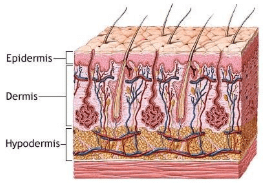
Skin Derivatives
Throughout the higher vertebrates the Keratin filled epithelium develops into a variety of special structures called skin derivatives.
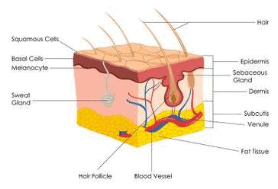
- Hairs—These are specialized, elongated, thread like, cylindrical outgrowth formed from epidermis. Each hair is grown in a hair follicle having a base, hair papilla through which nerve and blood supply enter the hair. The oil secretion from sebaceous glands lubricates the hair. Though epidermal in origin, hair follicles rests in dermis.
- Epidermal glands—These are quite abundant in mammalian skin. These are namely sebaceous, sweat, lachrymal, mammary and scent glands. They are present in dermis but all epidermal in origin.
- Sebaceous glands—Flask shaped, alveolar glands, formed as epithelial outgrowths, their oily secretion called sebum keeps the hairs and skin soft, greasy and oil proofed.
- Sweat glands—Coiled tube like in the dermis, open on the outer surface of skin, the gland separates a saline fluid from blood called sweat. It is a secretion (because it contains water which when poured over the skin surface and evaporated, cools down the body) as well as an excretion (because it contains urea). Sweat also contains useful salts such as sodium chloride.
- Mammary glands—These are modified sebaceous glands that produce milk. These are functional only in females but they remain undeveloped and functionless in males.
- Lachrymal glands—These are associated with eyes and secrete tears which keep the eyes and eyelids clean and moist.
- Meibomian glands—They open into the follicles of eye lashes. Their only secretion lubricates and keeps them soft and flexible.
- Scent glands—These are variously modified and differently located in the mammalian body. Their secretions serve to attract members of opposite sexes or for protection against enemies.
- Wax glands—They are present in auditory canals. The fatty secretion of them called earwax or cerumen lubricates and protects tympanic membrane of the ear.
- Other derivatives of skin are: Soles, palms, nails, claws, hoops, horns and horn like structures of animals, feathers of birds and dermal scales of fishes.
Chromatophores
Colour of the skin is due to the pigment cells called chromatophores located in the upper part of dermis. These are typically stellate in form and contain numerous granules. These are of following types:
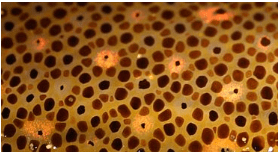
Melanophores—Contain dark brown or black pigment called melanin. Found in epidermis of man.
Erythrophores—Contain red granules.
Lipophores—Contain yellow pigment.
Guanophores or Iridophores — Contain no pigment but tiny crystals (Guanine) which by light reflection may alter the effect of the pigment materials.
Dentition and Salivary Glands - The arrangement of teeth is known as dentition. The dentition may be of the following types:
(A) Based on the succession of teeth:
Polyphyodont—When teeth can be replaced an indefinite number of times during life. For example, lower vertebrates.
Diphyodont—When teeth develop during life in two successive sets, first set is called deciduous, lacteal or milk teeth, later on these are replaced by second set called permanent teeth.
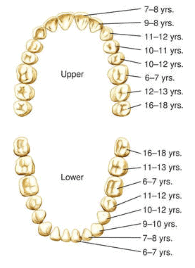
Monophyodont—When only one set of teeth develops. e.g. platypus, Moles, Marsupials, Sirenians, Toothless Whales etc.
(B) Based on the kind of teeth: Incisors—Curved, long and sharp edged. Help for seizing, cutting, cropping, biting and gnawing. They are variously modified.
Gnawing—in Rodents and Lagomorphs.
Combing—in Lemurs.
Tusks—in elephants, upper incisors modified as tusks.
Totally Absent—in sloths.
Absent in upper jaw—in ox.
Canines—Elongated, conical, sharp. Help in piercing and tearing the food as well as for defence and offence. Often large sized in males.
Tearing food—in carnivores.
Absent—in Rodents, Lagomorphs, some ungulates.
Premolars and Molars (Check teeth)—They both help in crushing, chewing and grinding. In carnivores last upper premolars and first lower molars are specialized and are called carnassial teeth, for cracking bones etc.
No of teeth in man Milk set 20 Adult set 32
Receptors on the tongue
Sour taste receptors—on the edge of the tongue.
Salt taste receptors—on the tip and at the sides.
Bitter taste receptors—at the base.
Sweet taste receptors—At the tip.
In man last molars are called “wisdom teeth”.
On the tongue of man there are different types of papillae such as filiform, fungi form and circumvallate types.
Three pairs of salivary glands open into the mouth cavity:
Parotid gland — It is located below and in front of the ear. Its duct opens on the inside of the cheek, opposite upper second molar tooth; the duct is called Stensen’s duct.
Submaxillary gland—It is located in the posterior part of the floor of mouth. Its duct opens on the floor of the mouth cavity at the sides of the frenum and is known as Wharton’s duct.
Sublingual gland—It is located in the anterior part of the floor of mouth cavity below the tongue. Several ducts of this gland open into the floor of the mouth.
The salivary glands produce saliva, a watery but viscous fluid that contains mucin and two hydrolytic enzymes, ptyalin and maltase, which act upon carbohydrates.Saliva is useful in several other ways. It keeps the mouth moist and aids speech. It cleanses the mouth cavity and removes unwanted particles.
Mumps is an acute virus infection of the parotid salivary glands characterized by swelling of the glands. It becomes difficult to open the mouth and swallow. The mouth also falls short of saliva.
Muscular System
Muscular System plays a key role in the life of animal. In addition to locomotion, muscles perform a number of significant functions associated with digestion, respiration, circulation, excretion and reproduction. Muscles also help in maintaining a particular posture of the animal. They are of the following main types:
Smooth or Visceral or Involuntary or Unstriated or Unstriped muscles—Occur in internal or visceral organs (digestive tract, arteries, veins etc.); slow to contract; contraction and relaxation is partly controlled by autonomic nervous system.
Skeletal or Striated or Striped or Voluntary muscles—Occur in body wall and limbs as well as in some internal organs (tongue, pharynx and beginning of the oesophagus); contract most rapidly and vigorously; mainly attached to bones or tendons thus mainly responsible for movements of skeleton.
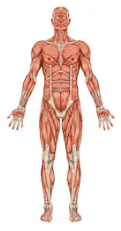
Cardiac or Heart muscles—They are available in heart only; they are involuntary. Contraction is not under the control of will; they are supplied by both sympathetic and parasympathetic nerves.
Tendon—A tough inelastic cord attaching a muscle to the sheath of a bone so that contraction of the muscle can bring about movement of the bone. They are largely made of white collagen fibres.
Ligament—A strip of elastic tissue holding two bones together at a joint.
Tetanus—It is a sustained contraction of muscle produced by the fusion of twitches.
Fatigue—If a muscle is stimulated repeatedly at intervals not close enough to produce tetanic contraction, it does not contract. The muscle which does not respond to stimuli at all, is said to be in a state of fatigue. This is due to accumulation of lactic acid in the muscle.
Difference between Voluntary, Involuntary and Cardiac Muscles | ||
Voluntary Muscles | Involuntary Muscles | Cardiac Muscles |
1. Long, cylindrical and non-tapering cells. | Long and spindle-shaped cells. | Fibres form a network. |
2. Sarcolemma is present. | Sarcolemma is absent. | Sarcolemma is present. |
3. Fibers are multinucleated. | Fibers are uninucleated. | Fibers are uninucleated. |
4. Alternate light and dark bands are present giving striated appearance. | No light and dark bands giving smooth appearance. | Cross-striations are present. |
5. Fibers contract at will. | Fibers contract with will. | Fibers contract without will. |
6. Fibers are subjected to fatigue when overworked. | No fatigue. Shows slow contractions. | No Fatigue. Rhythmic and autonomic contractions. |
7. Shows fast contractions. | They are poorly supplied with | They are richly supplied |
|
90 videos|491 docs|209 tests
|
FAQs on Animal Tissue, Skeletal System - Science & Technology for UPSC CSE
| 1. What are animal tissues and why are they important? |  |
| 2. How many types of animal tissues are there? |  |
| 3. What is the role of the skeletal system in animals? |  |
| 4. How does the skeletal system interact with other body systems? |  |
| 5. How can we maintain a healthy skeletal system in animals? |  |

















